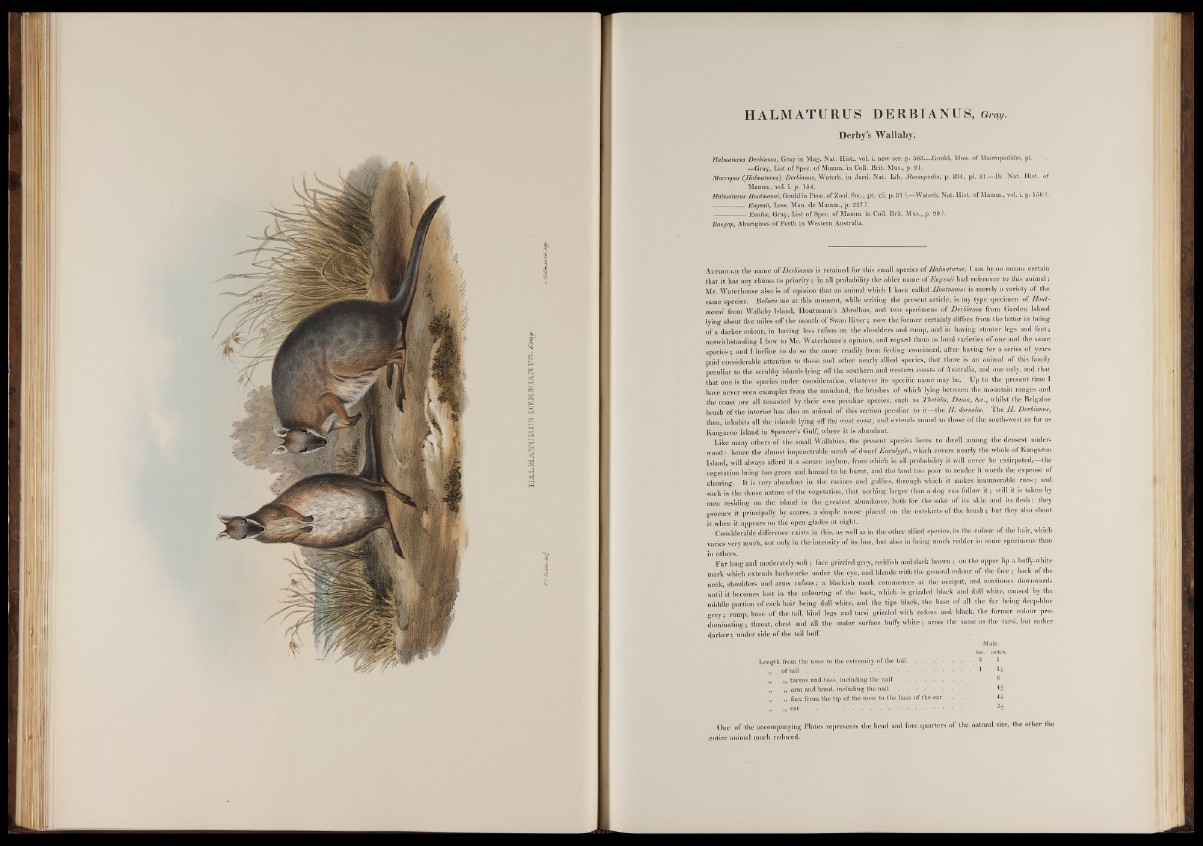
| K 9 |
HAIMATITRIUS ZHKRBIAJSritrS.
HALMATURUS DERBIANUS, Gray.
Derby’s Wallaby.
Halmaturus Derbianus, Gray in Mag. Nat. Hist., vol. i. new ser. p. 583—Gould, Mon. of Macropodidse, pi.
—Gray, List of Spec, of Mamm. in Coll. Brit. Mus., p. 91.
Macropus (Halmaturus') Derbianus, Waterh. in Jard. Nat. Lib. Marsupialia, p. 234, pi. 21.—Ib. Nat. Hist, of
Mamm., vol. i. p. 154.
Halmaturus Houtmanni, Gould in Proc. of Zool. Soc., pt. xii. p. 31 ?,—Waterh. Nat. Hist, of Mamm., vol. i. p. 156 ?.
--------------Eugenii, Less. Man. de Mamm., p. 227 ?.
-------------- Emilia, Gray, List of Spec, of Mamm. in Coll. Brit. Mus., p. 90 ?.
Ban gap, Aborigines of Perth in Western Australia.
Although the name of Derbianus is retained for this small species of Halmaturus, I am by no means certain
that it has any claims to priority; in all probability the older name of Eugenii had reference to this animal;
Mr. Waterhouse also is of opinion that an animal which I have called Houtmanni is merely a variety of the
same species. Before me at this moment, while writing the present article, is my type specimen of Houtmanni
from Wallaby Island, Houtmann’s Abrolhos, and two specimens of Derbianus from Garden Island
lying about five miles off the mouth of Swan River; now the former certainly differs from the latter in being
of a darker colour, in having less rufous on the shoulders and rump, and in having stouter legs and feet;
notwithstanding I bow to Mr. Waterhouse’s opinion, and regard them as local varieties of one and the same
species ; and I incline to do so the more readily from feeling convinced, after having for a series of years
paid considerable attention to these and other nearly allied species, that there is an animal of this family
peculiar to the scrubby islands lying off the southern and western coasts of Australia, and one only, and that
that one is the species under consideration, whatever its specific name may be. Up to the present time I
have never seen examples from the mainland, the brushes of which lying between the mountain ranges and
the coast are all tenanted by their own peculiar species, such as Thetidis, Dama, &c., whilst the Brigaloe
brush of the interior has also an animal of this section peculiar to it—the H dorsalis. The H. Derbianus,
then, inhabits all the islands lying off the west coast, and extends round to those of the south-west as far as
Kangaroo Island in Spencer’s Gulf, where it is abundant.
Like many others of the small Wallabies, the present species loves to dwell among the densest underwood
: hence the almost impenetrable scrub of dwarf Eucalypti, which covers nearly the whole of Kangaroo
Island, will always afford it a secure asylum, from which in all probability it will never be extirpated,—the
vegetation being too green and humid to be burnt, and the land too poor to render it worth the expense of
clearing. It is very abundant in the ravines and gullies, through which it makes innumerable runs; and
such is the dense nature of the vegetation, that nothing larger than a dog can follow i t ; still it is taken by
men residing on the island in the greatest abundance, both for the sake of its skin and its flesh: they
procure it principally by snares, a simple noose placed on the outskirts of the brush ; but they also shoot
it.when it appears on the open glades at night.
Considerable difference exists in this, as well as in the other allied species, in the colour of the hair, which
varies very much, not only in the intensity of its hue, but also in being much redder in some specimens than
in others.
Fur long and moderately soft; face grizzled grey, reddish and dark brown ; on the upper lip a buffy-white
mark which extends backwarks under the eye, and blends with the general colour of the face ; back of the
neck, shoulders and arms rufous; a blackish mark commences at the occiput, and continues downwards
until it becomes lost in the colouring of the back, which is grizzled black and dull white, caused by the
middle portion of each hair being dull white, and the tips black, the base of all the fur being deep-blue
grey; rump, base of the tail, hind legs and tarsi grizzled with rufous and black, the former colour predominating
; throat, chest and all the under surface buffy white; arms the same as the tarsi, but rather
darker; under side of the tail buff.
Male.
feet, inches.
Length from the nose to the extremity of the t a i l .....................................3 1
„ of t a i l .....................................................................................................S
„ „ tarsus and toes, including the n a i l ........................................... ®
,, „ arm and hand, including the n a i l ............................................
„ ,, face, from the tip of the nose to the base of the ear . . . 4^-
„ ,, e a r ..................................................... • ■ • 2-L
One of the accompanying Plates represents the head and fore quarters of the natural size, the other the
entire animal much reduced.